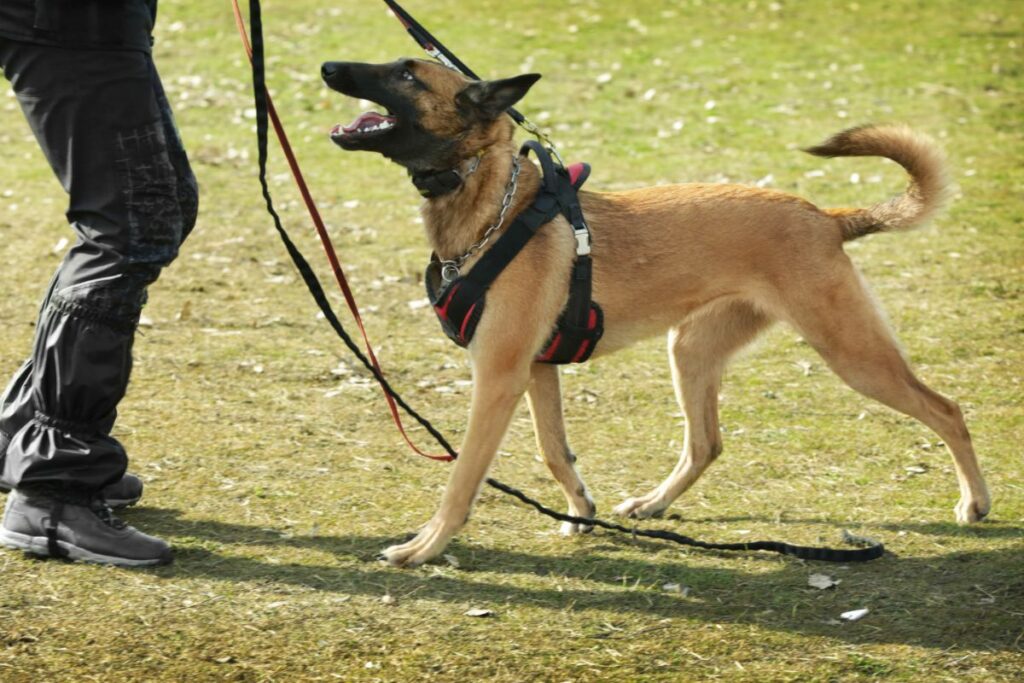Puppies learn a lot in the first few months of their lives. This learning stage can build their personalities and shape their behavior later on, benefitting their overall quality of life.
So, are immersive board and train programs worth it?

There are several factors worth taking into account. These include the length of the training, the quality of the training, and the behavioral goals you have in mind.
But by the end of this guide, you’ll have a better idea of whether dog board and train is the right decision for you and your dog.
Below, we explain everything you need to know about total immersion board and train, from what it involves to the benefits and disadvantages stacked up.
What Is Total Immersion Board And Train?
Total immersion board and train is a type of dog training program designed to help dog owners improve the behavior of their dogs – typically puppies. It’s a professional service offered by dog trainers and dog training facilities.
Board and train is considered fully immersive as your dog is required to stay with the trainer. During the agreed training period, the trainer will train your dog daily in various behavioral aspects that include obedience, socialization and interaction, and impulse control.
“Total immersion” dog board and train programs also go by other names, including immersive puppy training programs, dog training boot camps, dog boarding schools, and residential dog training.
How Long Is Board And Train?
Board and train programs can last anything from two weeks to six weeks, sometimes longer. This will depend on the services offered by the dog trainer or dog facility and the amount of training the dog needs.
The length of board and train is often recommended by a professional dog trainer after an initial evaluation.
The dog trainer will evaluate various factors, such as the dog’s behavior, temperament, obedience level, and more. Still, the agreed length of training is a decision ultimately made by the dog owner.
Is Immersion Board And Train Right For My Dog?
We know – it’s not easy to send your dog away, even if it is just for a few weeks. So, as a dog owner, you want to be 100% sure that placing your dog in a dog board and train program is the right decision.
There are a number of reasons for considering total immersion board and train. Some of these include early puppy training, instilling or improving general behavior, and personal constraints when it comes to training your dog yourself.
Puppy Training
Puppies start learning early on, especially during the age of 8–16 weeks. Puppies can be taught toilet training, basic commands, how to socialize and interact with people and other dogs, how to manage being left alone, and more.
So this important learning stage is one reason to consider dog board and train, as it can establish how your new puppy behaves and socializes for the rest of their life.
For this reason, some board and train programs cater exclusively to puppies.
Behavioral Problems
Does your dog display aggression to other dogs or people, destroy your furniture, or frequently pee and poo in the house?
These are just a few examples of behavioral issues that can be much harder to unlearn the older your dog becomes.
As a result, a professional dog trainer is sometimes needed. And since it takes time for dogs to establish new behavioral habits, an immersive board and train program is an option worth considering if your dog displays behavioral problems more often than not.
Shyness Or Fear
If your dog is excessively shy or fearful around other people and dogs or afraid of loud noises, such as fireworks, a board and train program can be an effective solution. The same also applies if your dog has a fear of being left alone.
This kind of behavior can limit their ability to positively interact with others as well as manage stressful situations.
Board and train programs often include training methods to help dogs overcome shyness and fear, some involving group dog training sessions, which can be especially helpful if you have a busy schedule.

What Is The Best Age For Dog Board And Train?
There is no “best age” for dog board and train, as it’s never too late to start training your dog.
Despite that, it’s worth knowing that many professional dog trainers and veterinarians consider an age of 12 to 16 weeks to be a crucial learning period for dogs.
For this reason, puppies may benefit more from dog board and train programs than dogs older than one or two years, from which they are typically considered “adults”.
No matter your dog’s age, however, an evaluation from a professional dog trainer can help you decide whether your dog will benefit from a board and train program.
Will My Dog Forget Me After Board And Train?
You wouldn’t be the only dog owner to worry about your dog forgetting you or even feeling abandoned at board and train.
Some fully immersive dog board and train programs can last over a month, during which your dog will be around totally new people in a completely new environment.
That said, you might be glad to know that your dog will still remember you.
Dogs have the memory capacity to remember their previous owners, and many board and train programs also offer owner involvement, so you’ll be able to visit your dog and get involved in certain aspects of the training.
What Does Immersive Board And Train Involve?
Before you inquire with a professional dog trainer or visit a board and train facility, it’s worth knowing what board and train programs generally involve.
This will help you understand what to expect from each program and, as a result, whether the board and train service meets your expectations.
Initial Evaluation
An evaluation is the first step in most board and train programs. This is where the professional dog trainer or dog behaviorist will assess your dog to decide and suggest the specific training it needs based on its current behavior and temperament.
This is also a good time to get to know the dog trainer on a personal level and discuss the behavioral goals you have in mind for your dog.
This can include anything from specific good behaviors to commands you would like your dog to learn.
Residential Stay
Board and train is a total immersion training method. This means your dog will stay onsite with the professional dog trainer for the full duration of the board and train program, whether that’s at the dog trainer’s home or a dog training facility.
A residential stay will allow your dog to fully immerse in the training environment, often with other dogs.
This ensures effective teaching without distractions or breaks in the training, which can hinder your dog’s ability to learn and retain new information.
Training Services
Board and train professionals and facilities typically offer a range of training services. This can be an all-round program for your dog that lasts several weeks or a program designed to address a specific area of dog behavior and obedience, such as collar training and commands.
Generally, a board and train program will provide a daily routine for your dog, which will progress and branch out to other areas across the duration of the training.
The routine is always worth inquiring about so that you know what your dog is doing and learning each day.
Socialization And Interaction With Other Dogs
Board and train programs, especially those carried out at dog training facilities, will typically involve a good amount of socialization and interaction with other dogs.
This might sound like your dog won’t receive as much attention, but the immersive environment is a good thing for several reasons!
Sharing safe spaces with other dogs can help your dog become more social, especially if your dog struggles to positively interact with other dogs and humans.
The group training sessions can also enhance the training process via visual learning, as well as improve your dog’s general mood during its stay.
Owner Involvement
You’ll find it reassuring to know that some board and train programs offer an element of owner involvement.
This can include anything from regular updates on your dog’s progress to being able to participate in some of the training activities yourself.
The benefit here is that you won’t miss your dog as much as you might think.
Actively participating in certain parts of the program will also help your dog develop the awareness that you are still their owner while enriching a fun and positive learning environment.
Transition Phase
Once the full board and train program is complete, many professional dog trainers and dog training facilities will work with you to ensure a smooth return home for your dog.
This includes reducing stress and providing guidance on how to maintain and reinforce what your dog has learned during their training.
The length of the transition phase can depend on the program, so it’s worth inquiring about what it involves and how long the professional dog trainer will help you after your dog’s train and board program is finished.
The Pros Of Dog Board And Train
Like most professional services and training programs, there are benefits and disadvantages. So, in addition to whether you think board and train is right for your dog, the pros and cons are just as important to weigh up.
Knowing these will also help you make a more informed decision before you place your dog in an immersion board and train program.

The Pros Of Dog Board And Train
1. Professional Expertise
The most obvious benefit of board and train is the professional guidance your dog will receive. So if you want to see results and fast, a professional board and train program is one of the most effective ways to train your dog.
2. Behavioral Training
Behavioral issues can be quickly addressed through a total immersion board and train program. This doesn’t just include problems such as aggression, but issues related to owner separation, social fear, and responses to loud noises.
3. Positive Learning Environment
Board and train programs offer a positive social environment that ensures fast learning. This includes expert trainers, routine activities, and the benefit of socializing and interacting with other dogs in safe spaces as needed.
4. Owner Learning
Through dog board and train, your dog isn’t the only one who will learn. You will also learn more about your dog via progress updates and information passed on from the dog trainer, including how to maintain and foster learning even after the program is complete.
5. It Saves You The Time And Effort
Training your dog can be both difficult and ineffective when you have a busy schedule. So if you don’t have the time, effort, or knowledge to train your dog effectively, a board and train program can be an easy solution.
The Cons Of Dog Board And Train
There are cons to immersive board and train programs, some less obvious than others.
So, while there are a handful of pros to board and train, it’s important to weigh them up against the cons before considering any program – even if it looks ideal for your dog.
Below are the disadvantages of dog board and train.
1. Possible Stress Of Adjustment
A change of environment and routine with new faces and experiences can be stressful for some dogs. No two dogs are the same either, so the adjustment period can take longer for some dogs, especially in cases where the dog may feel abandoned.
2. Learning In A Different Environment
Immersive board and train programs offer a positive environment for learning, but it’s also a completely different environment from your home. This may result in their training being gradually forgotten or unlearned, especially if the training isn’t reinforced.
3. Lack Of Owner Involvement
Some dogs only follow commands from specific people. So while they may learn new commands during board and train, some dogs might not follow commands from their owners if there’s a lack of owner involvement during the training.
4. Cost And Budget
Immersive dog board and train programs can be expensive. On top of that, the quality or duration of the program will depend on the program you can afford. For this reason, cheaper or less intensive board and train programs might not be as effective.
5. Missing Your Dog
It’s obvious, but true! Placing your dog in board and train for a few weeks can result in missing your favorite fur friend more than you thought. It may also come with feelings of guilt, which can make the process more difficult for some dog owners.
What Should You Look For In A Board And Train Program?
Have you decided to board and train your dog? In addition to finding the right dog trainer and program, there are a few more things you should look for before sending your furry friend away for a few weeks.
These include:
- Professionally recognized certifications
- Positive customer reviews and testimonials
- Friendliness of dog trainers and staff
- Good, clean, and safe dog training facilities
- A detailed rundown of what the program involves
- Owner involvement
- Post-program training guidance for dog owners
The above are all good signs of a reputable and trusted dog board and train program. You want to leave your dog in good hands, after all, so these are just as important to look at over cost and convenience.
If you’re still unsure about a program, nothing should stop you from talking to various dog trainers and dog training facilities to compare programs and receive different evaluations on what’s recommended for your dog.
Conclusion
A total immersion board and train program can be a rewarding investment through which your dog can immerse in learning valuable behavioral skills across several weeks that can benefit you and your dog for a lifetime.
But before committing to any program, it’s still worth weighing up the pros and cons of board and train, the board and train program itself, and whether you personally think it’s the best decision for your dog.
After all, you know your dog better than anyone!
Frequently Asked Questions
Is Residential Dog Training Worth It?
Residential dog training, also known as board and train, can be worth it for puppies and dogs with behavioral issues. These programs involve immersive professional training over several weeks, helping to shape and improve various aspects of dog behavior.
What Happens If You Don’t Train A Puppy?
Not training a puppy can lead to behavioral issues that can be difficult to correct in their adult years. From as early as eight weeks, puppies can be taught a variety of things, from collar and toilet training to self-control and good behavior with other dogs and humans.
What Age Is Too Late To Train A Dog?
It’s never too late to train a dog, even a dog that’s in its adult or senior years. Older dogs are just as capable of learning new behavioral skills, tricks, and commands, especially when treated with love, attention, and care.
- A Guide To Total Immersion Board And Train - August 24, 2023
- A Simple Guide On Teaching Your Puppy The Place Command - August 23, 2023
- A Pawprint Pets Guide To Puppy Breeds: Siberian Husky - August 14, 2023
